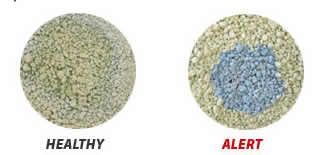
I just read an interesting article on new advances in cat litter–one that helps identify changes in the urine PH. This might be appreciated by pet veterinary insurance companies such as the one in California that said their number one claim in 2005 and 2006 was for urinary tract infections in felines.
Apparently the unique product was hard to develop and I can see it being useful for cats of all ages but especially to those who have experienced urinary tract infections before.
The litter is coated with a nontoxic PH detector so that the litter turns colors when the PH changes in a cat’s urine and the litter acts similarly to the strips used to test the PH in human urine or swimming pools. This is good because who wants to stick a PH strip under their cat when he or she is using the litterbox?
So, if the litter changes to a color out of the norm, it’s an indication the cat should visit the veterinarian for a diagnosis. Cat owners should seek veterinary care immediately and avoid trying to diagnose the situation if this happens.
In the animal field we are serious students of “poopology” (the study of poop). This is because some of the first signs of illness are just slight abnormalities in toileting habits, and the appearance (or quantity) of excrement/urine.
Animals usually hide their illness so the PH detecting litter can help detect an early problem. Unfortunately many people do not detect problems until treatment becomes very expensive or is too advanced to treat and perhaps this can help.
The new litter is supposed to also have all the qualities cat owners look for–such as moisture absorption and odor control.
If you decide to try this litter, it is important to determine what is normal for your cat—assuming you have already had a wellness check recently. Then, when there is a change it can be clearly identified and you can get the feline to the veterinary clinic immediately.
The manufacturer’s recommendation is that the diagnostic litter be used alone. Although it may be fine to mix litters while transitioning from one to another, be aware that the diagnostic litter may react when combined with another product.
Also, using odor-control products is discouraged since they may also cause the litter to react and proper storage (away from other chemical products) is important to keep the integrity of the product from being contaminated.
Read more about one PH detecting cat litter here or another one here. If you want to find an outlet that sells First Alert Cat Litter click here.

